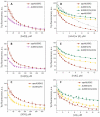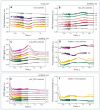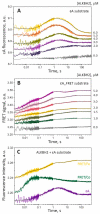Conformational Dynamics of Human ALKBH2 Dioxygenase in the Course of DNA Repair as Revealed by Stopped-Flow Fluorescence Spectroscopy
- PMID: 35956910
- PMCID: PMC9370705
- DOI: 10.3390/molecules27154960
Conformational Dynamics of Human ALKBH2 Dioxygenase in the Course of DNA Repair as Revealed by Stopped-Flow Fluorescence Spectroscopy
Abstract
Elucidation of physicochemical mechanisms of enzymatic processes is one of the main tasks of modern biology. High efficiency and selectivity of enzymatic catalysis are mostly ensured by conformational dynamics of enzymes and substrates. Here, we applied a stopped-flow kinetic analysis based on fluorescent spectroscopy to investigate mechanisms of conformational transformations during the removal of alkylated bases from DNA by ALKBH2, a human homolog of Escherichia coli AlkB dioxygenase. This enzyme protects genomic DNA against various alkyl lesions through a sophisticated catalytic mechanism supported by a cofactor (Fe(II)), a cosubstrate (2-oxoglutarate), and O2. We present here a comparative study of conformational dynamics in complexes of the ALKBH2 protein with double-stranded DNA substrates containing N1-methyladenine, N3-methylcytosine, or 1,N6-ethenoadenine. By means of fluorescent labels of different types, simultaneous detection of conformational transitions in the protein globule and DNA substrate molecule was performed. Fitting of the kinetic curves by a nonlinear-regression method yielded a molecular mechanism and rate constants of its individual steps. The results shed light on overall conformational dynamics of ALKBH2 and damaged DNA during the catalytic cycle.
Keywords: DNA methylation; DNA repair; FRET analysis; aminopurine; conformational dynamics; dioxygenase ALKBH2; fluorescent spectroscopy; pre-steady-state kinetics; stopped-flow.
Conflict of interest statement
The authors declare no conflict of interest.
Figures









Similar articles
-
Insights into the Direct Oxidative Repair of Etheno Lesions: MD and QM/MM Study on the Substrate Scope of ALKBH2 and AlkB.DNA Repair (Amst). 2020 Dec;96:102944. doi: 10.1016/j.dnarep.2020.102944. Epub 2020 Sep 9. DNA Repair (Amst). 2020. PMID: 33161373 Free PMC article.
-
A Single-Turnover Kinetic Study of DNA Demethylation Catalyzed by Fe(II)/α-Ketoglutarate-Dependent Dioxygenase AlkB.Molecules. 2019 Dec 13;24(24):4576. doi: 10.3390/molecules24244576. Molecules. 2019. PMID: 31847292 Free PMC article.
-
Transient kinetic analysis of oxidative dealkylation by the direct reversal DNA repair enzyme AlkB.J Biol Chem. 2020 May 22;295(21):7317-7326. doi: 10.1074/jbc.RA120.013517. Epub 2020 Apr 13. J Biol Chem. 2020. PMID: 32284330 Free PMC article.
-
The AlkB Family of Fe(II)/α-Ketoglutarate-dependent Dioxygenases: Repairing Nucleic Acid Alkylation Damage and Beyond.J Biol Chem. 2015 Aug 21;290(34):20734-20742. doi: 10.1074/jbc.R115.656462. Epub 2015 Jul 7. J Biol Chem. 2015. PMID: 26152727 Free PMC article. Review.
-
AlkB demethylases flip out in different ways.DNA Repair (Amst). 2008 Nov 1;7(11):1916-23. doi: 10.1016/j.dnarep.2008.07.015. Epub 2008 Sep 6. DNA Repair (Amst). 2008. PMID: 18723127 Review.
Cited by
-
Individual Contributions of Amido Acid Residues Tyr122, Ile168, and Asp173 to the Activity and Substrate Specificity of Human DNA Dioxygenase ABH2.Cells. 2023 Jul 13;12(14):1839. doi: 10.3390/cells12141839. Cells. 2023. PMID: 37508504 Free PMC article.
-
The Role of Key Amino Acids of the Human Fe(II)/2OG-Dependent Dioxygenase ALKBH3 in Structural Dynamics and Repair Activity toward Methylated DNA.Int J Mol Sci. 2024 Jan 17;25(2):1145. doi: 10.3390/ijms25021145. Int J Mol Sci. 2024. PMID: 38256217 Free PMC article.
References
-
- Ringvoll J., Nordstrand L.M., Vagbo C.B., Talstad V., Reite K., Aas P.A., Lauritzen K.H., Liabakk N.B., Bjork A., Doughty R.W., et al. Repair deficient mice reveal mABH2 as the primary oxidative demethylase for repairing 1meA and 3meC lesions in DNA. Embo J. 2006;25:2189–2198. doi: 10.1038/sj.emboj.7601109. - DOI - PMC - PubMed
MeSH terms
Substances
Grants and funding
LinkOut - more resources
Full Text Sources
Molecular Biology Databases

